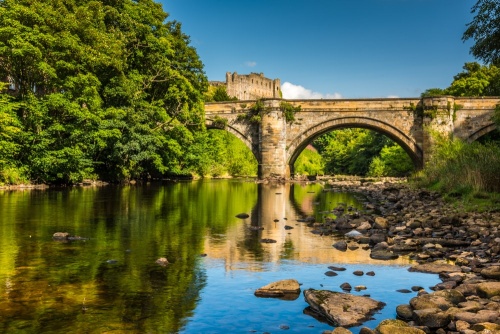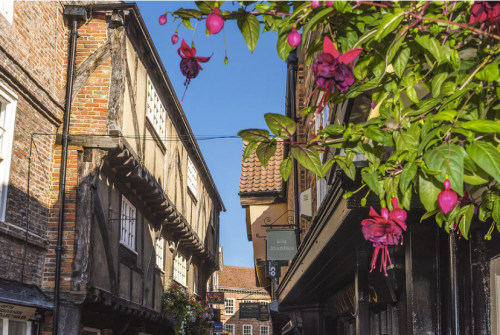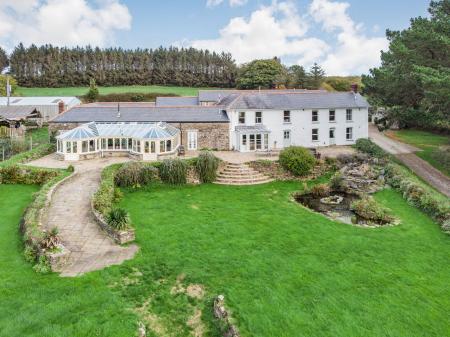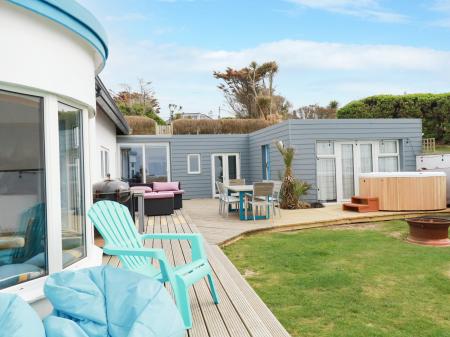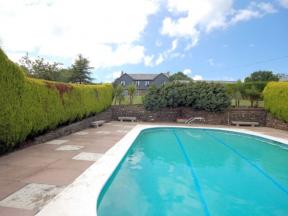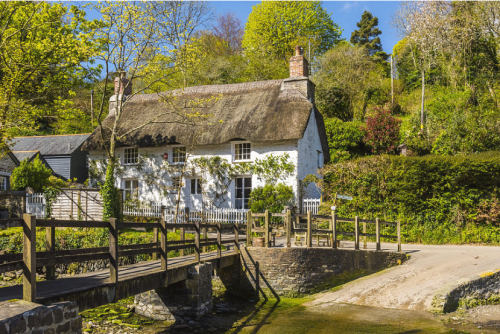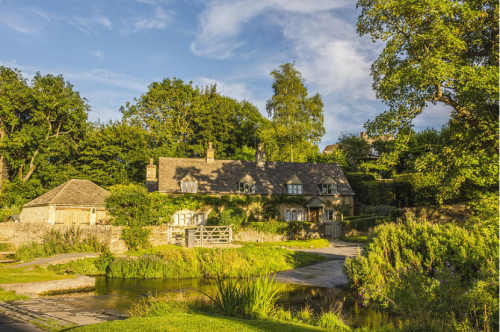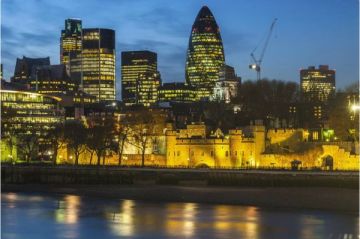Over the past 20 years of exploring England from Cumbria to Kent and London to Land's End I've frequently said to myself, 'I could live here!'. So, let's have some fun; here are nine fantastic places where I could happily live. I'm lucky enough that I actually do live extremely close to one of them!
All of these places boast wonderful scenery and a rich history. Some are well-known, others are relatively obscure. There's one historic city on the list, five towns, and three villages. Let's get started.
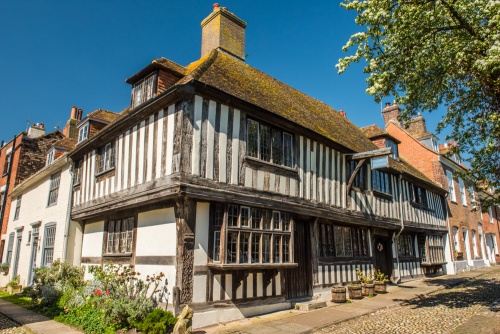
Richmond is an attractive market town on the River Swale, with easy access to the Yorkshire Dales on one side and to the North York Moors on the other. It also sits close to the A1(M), making York and Harrogate easy to reach if you head south, and County Durham and Northumberland easy to reach if you head north. That's the location, but what about Richmond itself?
Wow.
If you enjoy history like our family does, you'd be hard-pressed to find a more fascinating historic market town than Richmond. The most obvious example of that history is Richmond Castle, the superb 11th century Norman castle that rises above the River Swale and looks down on Richmond's market place.
The castle was begun by the Norman lord Alan 'the Red' shortly after the Norman Conquest. It was later owned by Richard, Duke of Gloucester (who became Richard III). The castle is now in the care of English Heritage and you can climb to the parapet walk for amazing views over Richmond and the surrounding countryside.
Richmond boasts some excellent examples of Georgian architecture, including the Georgian Theatre Royal, founded in 1788 and thought to be the oldest working theatre in its original form anywhere in Europe. Within the theatre is the oldest set of scenery in Britain, a woodland scene painted on boards around 1818.
Just south of Richmond is Easby Abbey, a 12th-century monastery established by Roald, the Constable of Richmond Castle, for the Premonstratensian order of canons. Beside the abbey ruins stands St Agatha's Church, boasting a superb set of wall paintings created around 1250.
In Richmond's large market square is The Obelisk, a striking monolith erected in 1788 to replace a medieval market cross. A short stroll from the market place brings you to Grey Friars Tower, all that remains of a 13th-century Franciscan friary.
Walk further and you come to the Richmondshire Museum, where you can learn more about the Richmond area. One of the museum highlights is a reconstructed 15th-century cruck house, salvaged from destruction and reassembled at the museum.
Richmond is so full of history, and perfectly placed for accessing the Yorkshire Dales. Our family has visited many times and have started to think seriously about investigating houses for sale in the area.
Bamburgh is a very popular seaside village, dominated by the imposing bulk of Bamburgh Castle, a medieval castle remodelled during the 17th and 19th centuries to become a comfortable stately home. The castle looks out over a broad, sandy beach, which sweeps around the coast to the dramatic ruins of Dunstanburgh Castle.
If you turn your gaze out to see you will spot the Farne Islands, famous for their seabird colonies. You can take boat trips to the Farne Islands from nearby Seahouses. On the furthest of the islands is Longstone lighthouse, once the home of lighthouse keeper William Darling and his family.
In 1838 William and his daughter Grace rowed through a fierce storm to rescue sailors and passengers of the SS Forfarshire, which had run aground in the heavy seas. Grace Darling became a national heroine for her role in the rescue, and when she tragically died 4 years later of tuberculosis there was an outpouring of grief across the nation.
Grace Darling's ornate tomb stands in the graveyard of St Aidan's Church. The church is a 13th-century building on the site of a 7th-century church built by St Aidan himself. His shrine stands in the chancel. Across the road from the churchyard is the RNLI Grace Darling Museum, recounting the tale of Bamburgh's favourite daughter.
Travel up the Northumberland Coast and you come to Holy Island, reached only by a causeway at low tide. On the island stand the ruins of Lindisfarne Priory, one of the first outposts of Christianity in England, founded by St. Aidan in the 7th century. Lindisfarne Priory is known for the exquisite Lindisfarne Gospels, an illuminated manuscript created here in the early 8th century. Also on Holy Island is Lindisfarne Castle, a Tudor fort later remodelled as a stately home.
We have visited Bamburgh on several occasions and enjoyed ourselves immensely. It is a very attractive village, and if you are fortunate enough to visit on a late summer evening, the views of Bamburgh Castle from the beach, lit by the last light of the setting sun, is enough to take your breath away!
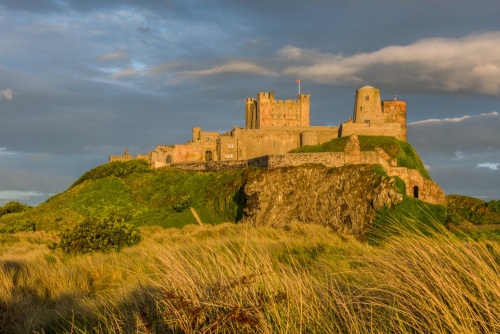
My favourite historic city in England (though Oxford and London are close behind). The wonderful thing about York is how the past is always present; everywhere you look are reminders of York's history, and that history is integrated into modern York like a second skin.
Walking the medieval city walls is like getting an overview of history. Look down on remnants of a Roman fort, up to the soaring towers of York Minster, cross the surviving medieval bars, or gateways to the city, such as Bootham Bar and Monks Bar.
On our last visit, my wife and I took a break from sightseeing and had a well-earned cup of coffee at the cafe built into Walmgate Bar. Where else in England can you sip a decaf latte while seated on the parapet walk of a medieval gatehouse?
York boasts superb museums such as the Yorkshire Museum and the outstanding National Railway Museum, but my favourite is the York Castle Museum, with its recreations of historical street scenes from York's past. Then there's the Jorvik Viking Centre, built directly over remains of Viking York.
A few steps away is Fairfax House, a superb Georgian residence, and a stone's throw from Fairfax House is Clifford's Tower, all that remains of the medieval fortress of York Castle. And those are just a few historical highlights.
Stroll along the River Ouse in the evening or take a river cruise on a long summer evening and see if you don't fall in love with York, as our family has done.
4. Appleby-in-Westmorland, Cumbria
The Lake District gets all the publicity, and most of the visitors, and that's understandable, for it truly is a wonderfully scenic area. I love to explore the Lakes; for an avid photographer like me they are heaven on earth. But if you ask me where I'd actually like to live I'd choose the Eden Valley, centred on the attractive town of Appleby-in-Westmorland.
One of the reasons is purely practical; the Lake District gets insanely crowded, especially in the summer months. There are times when it feels like you can't take a step without running into another sightseer. The lines of traffic inching their way through the narrow lanes of the Lake District National Park are infamous.
Head a score of miles east to the Eden Valley and the traffic disappears. Now you can draw a deep breath and enjoy the stunning scenery in peace.
True, there are no lakes, but there is a beautiful valley of picturesque villages, waterfalls, and ruined castles. Appleby itself is as pretty as anywhere in the Lakes. There's Appleby Castle (privately owned) and the historic almshouses established by Lady Anne Clifford, whose tomb is in the medieval parish church of St Lawrence.
Appleby is famous for its annual horse fair, when travellers descend on the area to buy and sell horses, but at other times of the year it is relatively quiet. It also gives easy access to the Lake District. A perfect solution!
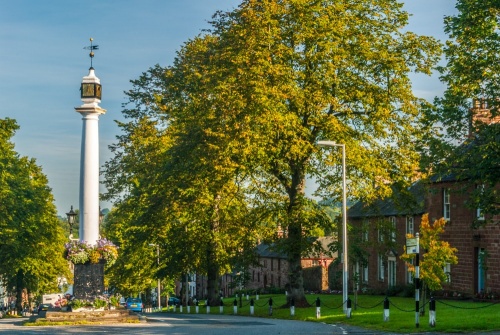
5. Eye, Suffolk
I could have picked a dozen places in Suffolk, like Clare or Kersey, but I've chosen the wonderful little town of Eye, just a few miles from the Suffolk border with Norfolk. The town name comes from the Saxon word for an island, a reminder that Eye was at one time surrounded by marshland.
Eye was at one time the smallest borough in England and it still has a very small-town feel. And if you enjoy history and historic buildings you will love exploring the town.
The best place to get a good view of historic Eye is from the top of Eye Castle. The castle began as a simple Saxon motte, or earthwork mound, in the 11th century, surrounded by a bailey enclosure. Stone curtain walls were added in the 12th century and Thomas Becket, Archbishop of Canterbury, built the first stone fortifications.
You can climb the castle mound to the level of the ramparts and look out over the town, and across to the medieval parish church of St Mary. This superb 14th-century church boasts a medieval painted screen, a pair of Tudor tombs, and a remarkable modern rood by Sir Ninian Comper. Beside the church is the timber-framed medieval Guildhall, dating to the 15th century.
A short walk from the Guildhall brings you to a 'crinkle-crankle' wall, a very high serpentine red brick wall enclosing the grounds of Chandos Lodge. Nearby is the rather peculiar Victorian town hall of brick and flint, while a short stroll around the town takes you past several attractive thatched cottages.
Eye is just a few miles from the market town of Diss and within relatively easy reach of the Suffolk coast.
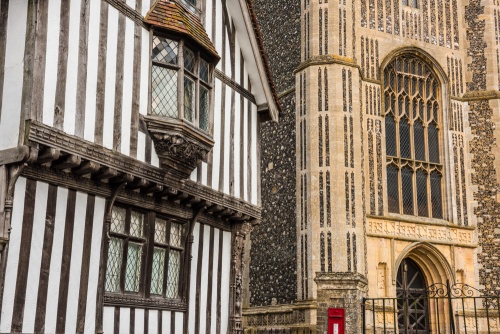
Ah, Framlingham! I've been here four times and I wish it was 400! This attractive market town in north-east Suffolk is best-known for Framlingham Castle, a moated 12th-century castle defended by a perfectly-preserved curtain wall. There has been some form of fortification on the castle site since at least the 6th century.
The castle we see today was begun by the powerful nobleman Roger Bigod, though it was rebuilt in stone by his son and grandson the first two Earls of Norfolk. King John besieged Framlingham Castle in 1216 and the castle garrison only held out for two days before surrendering to the king. The castle used as a prison for Catholic priests under Elizabeth I and late became a poorhouse, a courthouse, and a fire station.
I've photographed the castle on several occasions, usually from across the Mere, which forms part of the castle moat on the west side. To stand by the side of the Mere and watch the late evening sun illuminate the castle walls while the bells of St Michael's Church peel out and echo across the water is one of my most abiding memories from over 20 years exploring England. The Mere is a large area of wetlands now preserved as a nature reserve.
In St Michael's Church (or, more precisely, St Michael the Archangel), you will find tombs of the Howard family, Dukes of Norfolk and former owners of Framlingham Castle. There are 5 Howard tombs in Framlingham, each one an impressive statement of the family's status and wealth. The oldest tomb is that of Henry Fitzroy, an illegitimate son of Henry VIII. St Michael's also boasts a late 17th-century organ thought to be the oldest in any English parish church.
Framlingham is a delight to explore. It is large enough to have plenty of interest and lots of visitor facilities, yet small enough to feel welcoming and easy to get around. A few miles away at Saxtead Green is a historic post mill built in 1860 and now preserved by English Heritage. Framlingham is well-placed for easy access to the Suffolk coast at Aldeburgh or south to Ipswich.
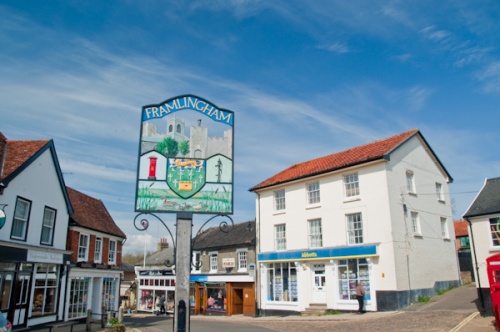
Rye is one of the original 'Cinque Ports', an organisation of important coastal towns that gained special legal status in the medieval period and in exchange had to help defend the south coast of England from attack. It is hard to imagine Rye as a busy port today; the sea has receded, leaving Rye looking out over a low coastal plain.
On that plain, within a short walk from the town centre, is Camber Castle, built by Henry VIII to defend Rye against a French invasion. When it was built the castle stood on the edge of Rye harbour but the retreating sea means that it now sits in the centre of a broad plain, far from the sea.
The town is blessed with a wonderful collection of historic buildings and cobbled lanes centred around the medieval church of St Mary. You can climb the church tower for one of the best views in East Sussex. The church boasts a wonderful collection of Victorian stained glass by William Morris and a Tudor clock with an 18-foot long pendulum. The quarter hours are struck by a pair of gilded cherubs.
The church overlooks Ypres Tower, sometimes erroneously called Rye Castle. The tower was built in 1249 and is named for a former owner, a cloth merchant named John of Ypres. It was one of the few buildings in Rye to survive an attack by the French in 1377 and was later used as a courthouse, gaol, and mortuary. It is now a fascinating museum of Rye's rich heritage.
If you stroll along the cobbled lanes from Ypres Tower you will pass several attractive timber-framed building before reaching Lamb House, an attractive 18th-century brick house that was once the home of writer Henry James.
He was not the most famous person to stay at Lamb House; that honour goes to King George I. In 1726 the king's ship was forced aground off Rye in a storm and Lamb House was considered the only house in Rye suitable to offer the king accommodation.
Around the corner from Lamb House is Mermaid Street, arguably the most attractive street in England, lined with historic timber-framed buildings including the Mermaid Inn, one of the oldest buildings in Rye with a history going back to at least 1156.
That's just a taste of Rye itself; a bit further afield is Smallhythe Place, a picturesque 16th-century half-timbered house once owned by actress Ellen Terry and now maintained by the National Trust.
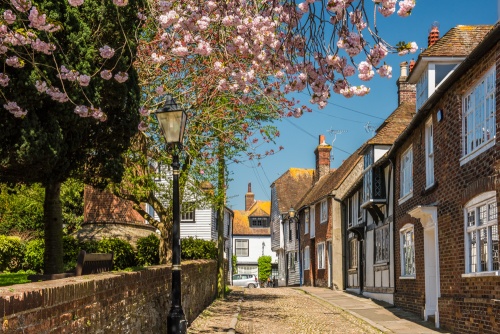
If you fancy getting away from it all, you can't do better than the beautiful Cornish village of Helford, in the north-east corner of the Lizard Peninsula.
Helford sits on the south bank of the Helford River, across from Helford Passage on the north shore. A foot passenger ferry takes summer visitors across the river - a very handy shortcut for walkers on the South West Coast Path National Trail who otherwise have to walk all the way up the river to Gweek and then back on the north bank.
Helford is incredibly picturesque, and it seems like half the whitewashed cottages are thatched, which only adds to the ambience. No visitor automobiles are allowed; there is a visitor parking area at the top of the hill leading down into the village and all visitors have to park there and walk in. That helps keep the village quiet and preserve the relaxed atmosphere.
There is a lovely waterside pub where you can relax on a terrace overlooking the inlet. What a place to sit and enjoy a long summer evening. There's also a village store, but that's it for facilities.
One famous visitor to Helford was author Daphne Du Maurier, who use the area as the setting for her novel Frenchman's Creek. You can take a footpath from Helford over the headland to the real Frenchman's Creek where Du Maurier's privateer moored his ship.
9. Upper Slaughter, Gloucestershire
This last one is a bit of a cheat on my part because we actually do live just a few miles away from Upper Slaughter and come here frequently on family walks. So, I suppose you could say that we already live here.
The name might need some explaining; it was not the scene of a battle, as you might reasonably suspect, nor does it have anything to do with violence at all. 'Slaughter' in this case comes from the same root word as 'slough', meaning a marshy place or mere.
At the centre of the village is a picturesque cobbled ford across the peaceful River Eye. If you don't fancy getting your feet wet there's also a small footbridge.
From the ford, the lane leads steeply up the hill to a complex of medieval almshouses. Behind the almshouses is the 12th-century parish church, dedicated to St Peter. Across the road from the church is the Lords of the Manor Hotel, one of the finest luxury country house hotels in the country, begun in 1649.
Beyond the hotel is another historic house, Upper Slaughter Manor, a picturesque Elizabethan manor house built by the Slaughter family. In my opinion, Upper Slaughter Manor is the quintessential Cotswolds manor house, set in an idyllic landscape so typical of the Cotswolds.
f you walk across the fields you come to Upper Slaughter's 'twin' village Lower Slaughter, one of the most popular destinations for photographers where golden-toned stone cottages line the River Eye and a quiet pool reflects the historic Old Mill.
A short walk again from Lower Slaughter brings you to Bourton-on-the-Water, known as the Venice of the Cotswolds for its series of picturesque footbridges over the peaceful River Windrush. From Bourton, you follow the old Roman road known as the Fosse Way to Stow-on-the-Wold, a pretty market town on top of a hill.
An old rhyme calls it 'Stow-on-the-Wold where the wind blows cold', but Stow is better known historically as the site of the last battle in the English Civil War. The entire area is incredibly picturesque, filled with chocolate-box villages and gorgeous Cotswold stone cottages.
These are just a few of dozens of places around England that we've explored and thought to myself, 'I could live here'. What's your favourite? Where would you live?
MOST POPULAR POSTS
